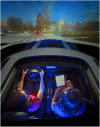AR DriveSim: An Immersive Driving Simulator for Augmented Reality Head-Up Display Research
- PMID: 33501113
- PMCID: PMC7805674
- DOI: 10.3389/frobt.2019.00098
AR DriveSim: An Immersive Driving Simulator for Augmented Reality Head-Up Display Research
Abstract
Optical see-through automotive head-up displays (HUDs) are a form of augmented reality (AR) that is quickly gaining penetration into the consumer market. Despite increasing adoption, demand, and competition among manufacturers to deliver higher quality HUDs with increased fields of view, little work has been done to understand how best to design and assess AR HUD user interfaces, and how to quantify their effects on driver behavior, performance, and ultimately safety. This paper reports on a novel, low-cost, immersive driving simulator created using a myriad of custom hardware and software technologies specifically to examine basic and applied research questions related to AR HUDs usage when driving. We describe our experiences developing simulator hardware and software and detail a user study that examines driver performance, visual attention, and preferences using two AR navigation interfaces. Results suggest that conformal AR graphics may not be inherently better than other HUD interfaces. We include lessons learned from our simulator development experiences, results of the user study and conclude with limitations and future work.
Keywords: augmented reality; conformal graphics; driving simulator; head-up display; human machine interface.
Copyright © 2019 Gabbard, Smith, Tanous, Kim and Jonas.
Figures








References
-
- Administration NHTS (2013). Visual-Manual NHTSA Driver Distraction Guidelines for In-vehicle Electronic Devices (No. NHTSA-2010-0053). Washington, DC: National Highway Traffic Safety Administration.
-
- Bolton A., Burnett G., Large D. R. (2015). An investigation of augmented reality presentations of landmark-based navigation using a head-up display, in Proceedings of the 7th International Conference on Automotive User Interfaces and Interactive Vehicular Applications (Nottingham: ACM; ), 56–63.
-
- Bower M., Howe C., McCredie N., Robinson A., Grover D. (2014). Augmented reality in education–cases, places and potentials. Educ. Media Int. 51, 1–15. 10.1080/09523987.2014.889400 - DOI
-
- Caird J. K., Chisholm S. L., Lockhart J. (2008). Do in-vehicle advanced signs enhance older and younger drivers' intersection performance? Driving simulation and eye movement results. Int. J. Hum. Comp. Stud. 66, 132–144. 10.1016/j.ijhcs.2006.07.006 - DOI
-
- Charissis V., Papanastasiou S. (2010). Human-machine collaboration through vehicle head up display interface. Cogn. Technol. Work 12, 41–50. 10.1007/s10111-008-0117-0 - DOI
LinkOut - more resources
Full Text Sources
Other Literature Sources
Research Materials

